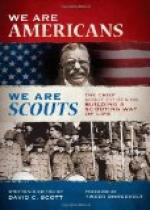He laughed and answered, “No, Willie, not quite as bad as that. Besides, I don’t think we are hungry enough to eat an Indian, if we had one cooked by a French cook; but what will be better, to my taste at least, the Indians are bringing us some Buffalo meat for our supper,” and sure enough they proved to be friendly.
They were a portion of the Caw tribe, which was friendly with the whites at that time. They had been on a hunt, and had been successful in getting all the game they wanted. When they rode up to our camp they surrounded Carson every one of them, trying to shake his hand first. Not being acquainted with the ways of the Indians, the rest of us did not understand what this meant, and we got our guns with the intention of protecting him from danger, but seeing what we were about to do, Carson sang out to us, “Hold on, boys. These are our friends,” and as soon, as they were done shaking hands with him Carson said something to them in a language I did not understand, and they came and offered their hands to shake with us. The boys and myself with the rest stood and gazed at the performance in amazement, not knowing what to do or say. These were the first wild Indians we boys had ever seen. As soon as the hand shaking was over, Carson asked me to give him my knife which I carried in my belt. He had given the knife to me when we left St. Louis. I presume Carson had a hundred just such knives as this one was in his pack, but he could not take the time then to get one out. For my knife he traded a yearling Buffalo, and there was meat enough to feed his whole crew three or four days. That was the first Indian “Pow-wow” that I had ever seen or heard of either.
The Indians ate supper with us, and after that they danced “the Peace Dance” after smoking the Pipe of Peace with Uncle Kit. The smoking and dancing lasted perhaps an hour, and then the Indians mounted their horses and sped away to their own village.
I was with Carson off and on about twelve years, but I never saw him appear to enjoy himself better than he did that night. After the Indians had gone, Uncle Kit imitated each one of us as he said we looked when the Indians first appeared in sight. He had some in the act of running and others trying to hide behind the horse, and he said that if the ground had been loose we would have tried to dig a hole to crawl into. One of the party he described as sitting on his pack with his mouth wide open, and he said he could not decide whether the man wanted to swallow an Indian or a Buffalo.
The next morning we pulled out from there, crossing the divide between this stream and the Arkansas. Just before we struck the Arkansas river, we struck the Santa-Fe trail. This trail led from St-Joe on the Missouri river to Santa-Fe, New Mexico, by the way of Bent’s Fort, as it was called then. Bent’s Fort was only a Trading Station, owned by Bent and Robedoux. These two men at that time handled all the furs that were trapped from the head of the North Platte to the head of the Arkansas; the Santa-Fe trail, as it was then called, was the only route leading to that part of the country.




